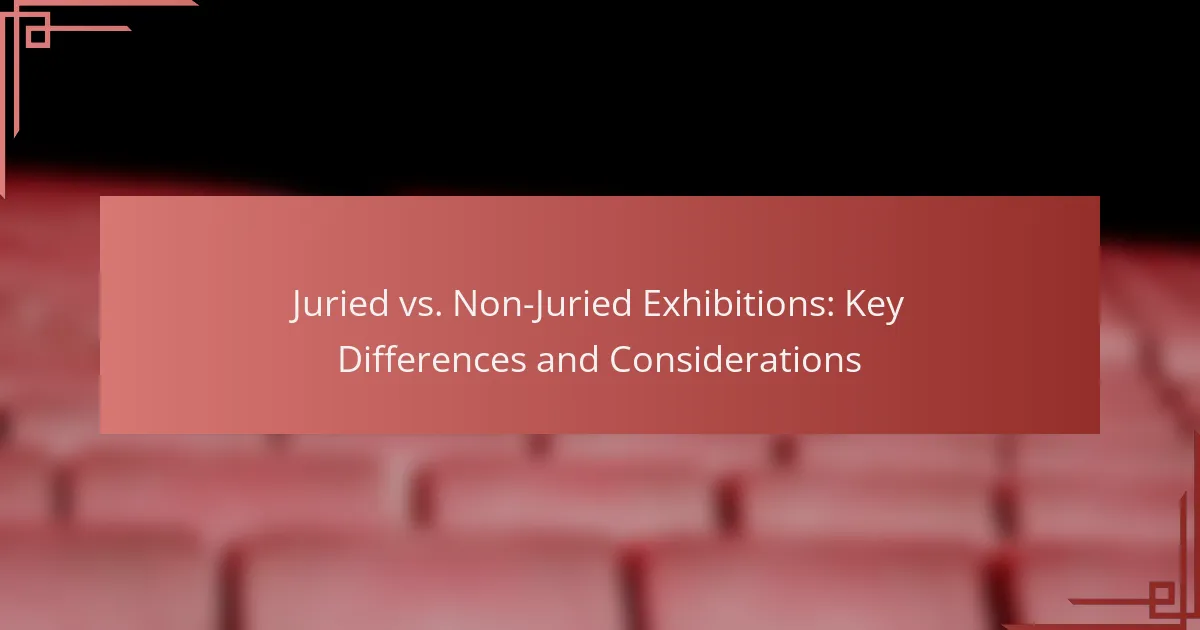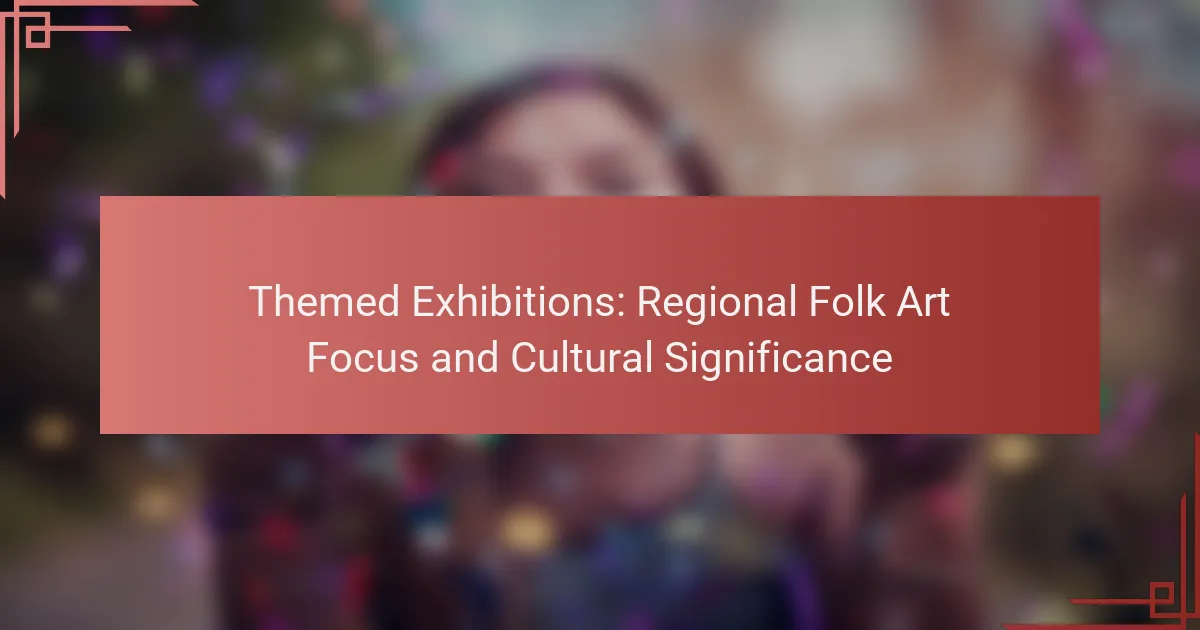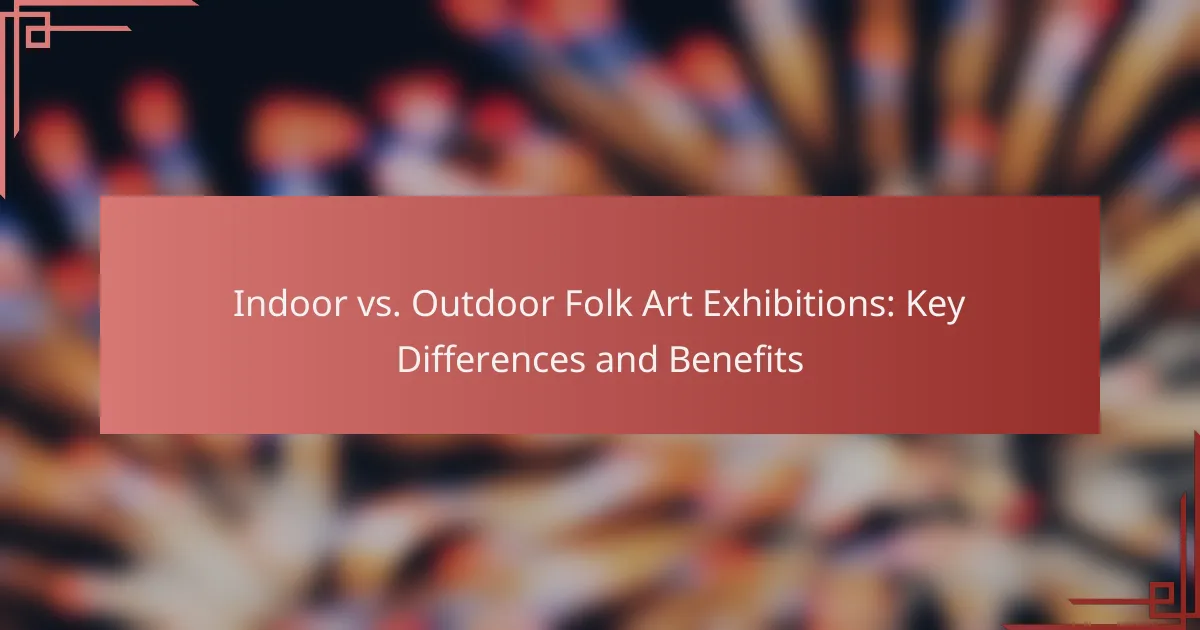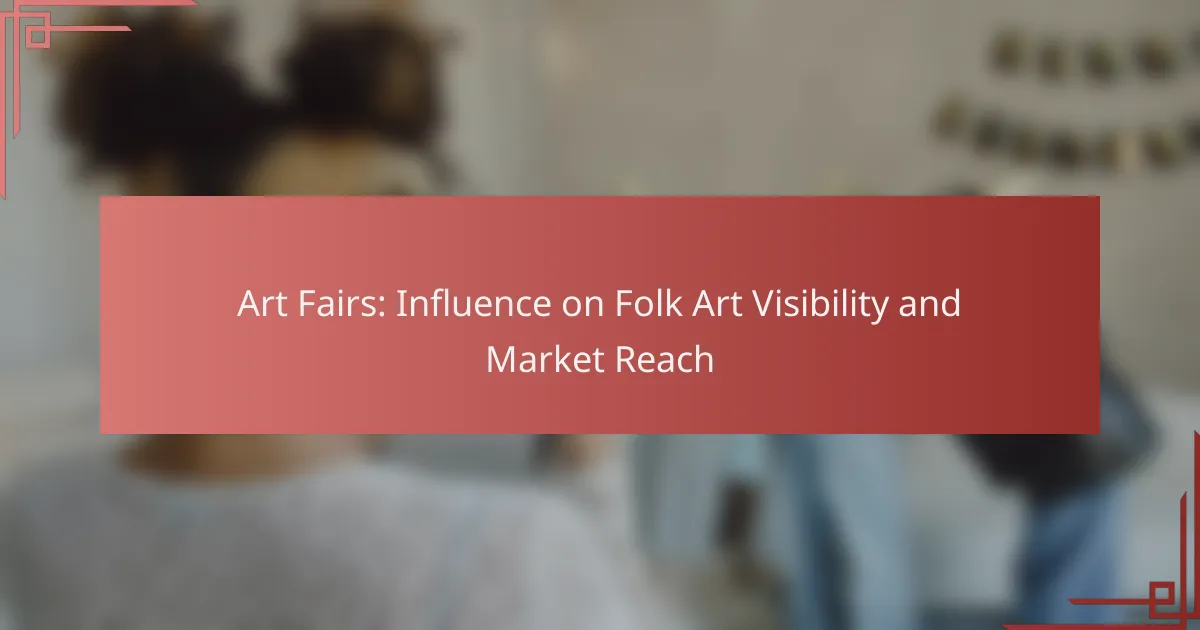Juried and non-juried exhibitions present distinct opportunities for artists, each with its own set of advantages and challenges. Juried exhibitions involve a selection process by a panel of judges, providing artists with professional recognition and potential career advancement. In contrast, non-juried exhibitions promote inclusivity by allowing all submissions to be displayed, making art accessible to a wider range of participants.
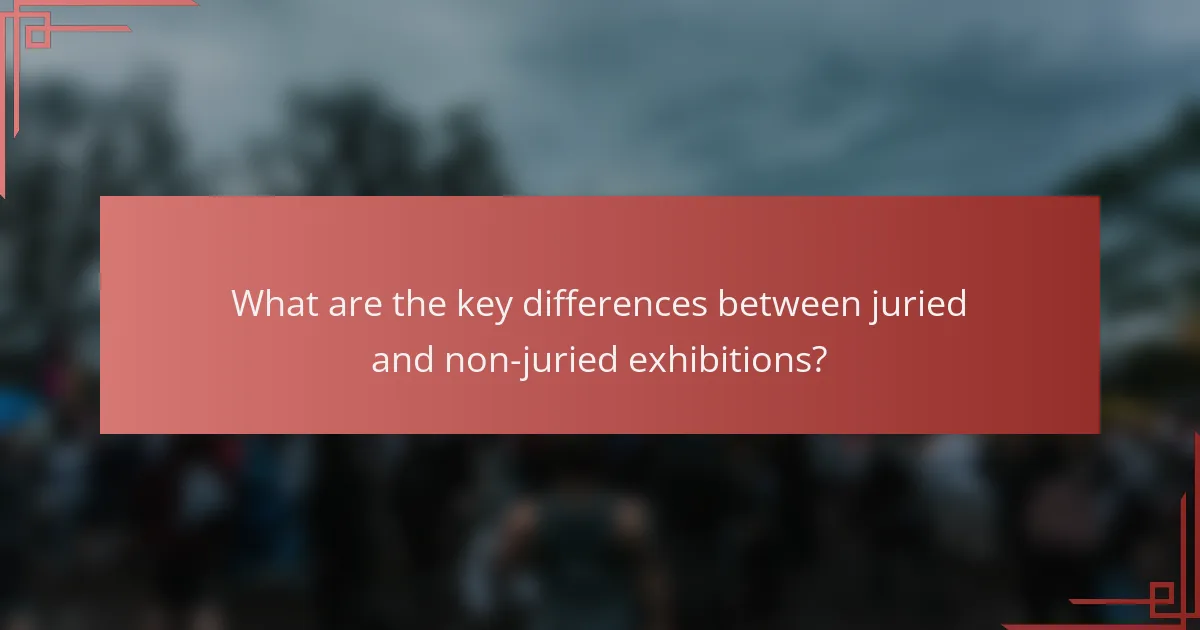
What are the key differences between juried and non-juried exhibitions?
Juried exhibitions involve a selection process where artworks are evaluated by a panel of judges, while non-juried exhibitions allow all submissions to be displayed. The main differences lie in the selection process, criteria for acceptance, and the overall impact on artists’ visibility and potential sales.
Selection process
In juried exhibitions, artists submit their work for review, and a panel of judges decides which pieces will be included. This process often includes an application fee and can be competitive, with only a fraction of submissions accepted. Non-juried exhibitions, on the other hand, typically allow all submitted works to be displayed, making them more accessible to a wider range of artists.
Criteria for acceptance
Juried exhibitions have specific criteria that artworks must meet, which may include technical skill, originality, and thematic relevance. These criteria are often outlined in the exhibition’s call for entries. Non-juried exhibitions usually lack strict acceptance criteria, focusing instead on inclusivity, allowing artists of varying skill levels to showcase their work.
Impact on artist visibility
Participating in a juried exhibition can enhance an artist’s visibility, as acceptance signifies recognition by peers and experts in the field. This can lead to increased opportunities for future exhibitions and sales. In contrast, non-juried exhibitions may not carry the same weight in terms of prestige, but they provide a platform for emerging artists to gain exposure without the pressure of competition.
Potential for sales
Juried exhibitions often attract collectors and art enthusiasts, increasing the potential for sales. Artists whose works are selected may find themselves in a better position to negotiate prices and commissions. Non-juried exhibitions may also lead to sales, but the likelihood can vary significantly based on the venue and audience engagement.
Reputation of the exhibition
The reputation of juried exhibitions is typically higher due to the rigorous selection process, which can enhance an artist’s credibility. Established galleries and institutions often host these events, adding to their prestige. Non-juried exhibitions can vary widely in reputation; while some may be well-regarded, others may be seen as less prestigious due to their open nature.

What are the benefits of juried exhibitions?
Juried exhibitions offer artists a platform for professional recognition and validation through a selection process by industry experts. These events can enhance an artist’s credibility and open doors to new opportunities in their career.
Professional validation
Participating in a juried exhibition provides artists with professional validation as their work is evaluated and selected by a panel of experts. This endorsement can significantly enhance an artist’s reputation and may lead to further opportunities, such as gallery representation or sales.
Artists often find that being part of a juried show can bolster their confidence and encourage them to pursue more ambitious projects. The recognition from peers and professionals can serve as a strong motivator for continued artistic development.
Networking opportunities
Juried exhibitions attract a diverse audience, including collectors, curators, and fellow artists, creating valuable networking opportunities. Engaging with industry professionals can lead to collaborations, exhibitions, and mentorships that might not be available through non-juried shows.
Artists should take advantage of these events to connect with others in the field. Attending openings and participating in discussions can help build relationships that may benefit their careers in the long run.
Higher quality of work displayed
Juried exhibitions typically feature a higher quality of work, as only selected pieces make it into the show. This selection process ensures that the displayed art meets certain standards, which can elevate the overall experience for both artists and attendees.
For artists, exhibiting alongside high-caliber work can inspire them to refine their craft and raise their own standards. Viewers also benefit from the opportunity to see a curated selection of exceptional art, enhancing their appreciation and understanding of contemporary practices.

What are the benefits of non-juried exhibitions?
Non-juried exhibitions offer several advantages, including broader access for artists and reduced financial barriers. These exhibitions allow all interested participants to showcase their work, fostering a more inclusive artistic community.
Accessibility for all artists
Non-juried exhibitions are open to any artist who wishes to participate, regardless of their experience level or background. This inclusivity encourages emerging artists to display their work alongside established professionals, creating a diverse array of artistic expressions.
By removing the selection process, these exhibitions enable artists from various demographics and regions to gain visibility. This can be particularly beneficial for those who may not have the resources or connections to enter juried shows.
Lower entry fees
Typically, non-juried exhibitions have lower entry fees compared to their juried counterparts. This financial accessibility allows more artists to participate without the burden of high costs, which can sometimes reach hundreds of dollars in juried events.
Lower fees can encourage participation from a wider range of artists, including students and those in the early stages of their careers. This can lead to a richer variety of artwork on display, enhancing the overall experience for attendees.
Freedom of expression
Non-juried exhibitions provide artists with greater freedom to express their ideas without the constraints of a judging panel. Artists can explore unconventional themes and techniques that might not align with the preferences of jurors.
This freedom fosters creativity and innovation, as artists feel empowered to take risks in their work. The resulting diversity in artistic expression can engage audiences in new and thought-provoking ways, making these exhibitions a valuable part of the art landscape.
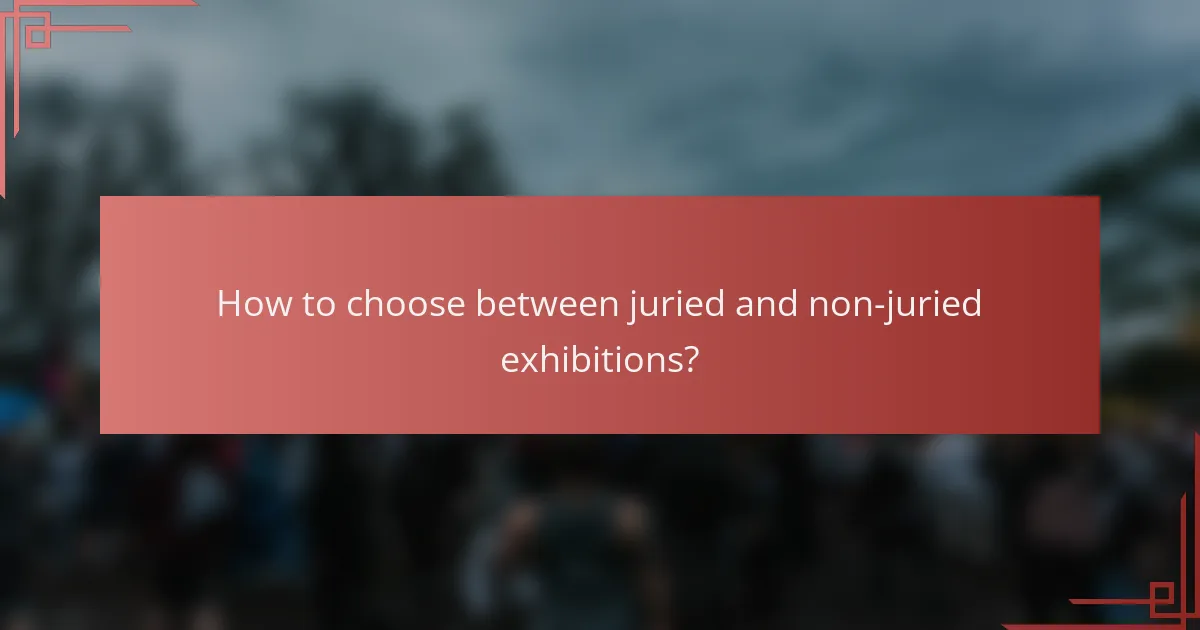
How to choose between juried and non-juried exhibitions?
Choosing between juried and non-juried exhibitions depends on your artistic goals and the exposure you seek. Juried exhibitions typically offer a competitive selection process that can enhance credibility, while non-juried exhibitions provide broader access and inclusivity.
Assessing personal goals
Your personal goals play a crucial role in deciding between juried and non-juried exhibitions. If you aim to gain recognition and credibility in the art community, juried shows may be more beneficial. Conversely, if your goal is to showcase your work to a wider audience without the pressure of competition, non-juried exhibitions can be a better fit.
Consider what you hope to achieve: networking opportunities, sales, or simply sharing your art. Aligning your choice with these objectives will guide you toward the right exhibition type.
Understanding target audience
Identifying your target audience is essential when choosing between exhibition types. Juried exhibitions often attract art collectors, critics, and serious enthusiasts looking for high-quality work, while non-juried exhibitions may appeal to a broader demographic, including casual viewers and local community members.
Think about who you want to reach with your art. If your work resonates with a specific niche, juried exhibitions may provide more focused exposure. For a wider reach, non-juried options can help you connect with diverse audiences.
Evaluating exhibition reputation
The reputation of the exhibition can significantly impact your decision. Juried exhibitions usually have a rigorous selection process, which can enhance your portfolio if accepted. Research the history and credibility of the jurors and the exhibition venue to ensure it aligns with your artistic vision.
For non-juried exhibitions, consider the venue’s reputation and the quality of past shows. While these exhibitions may not have the same level of prestige, a well-regarded venue can still provide valuable exposure and networking opportunities.
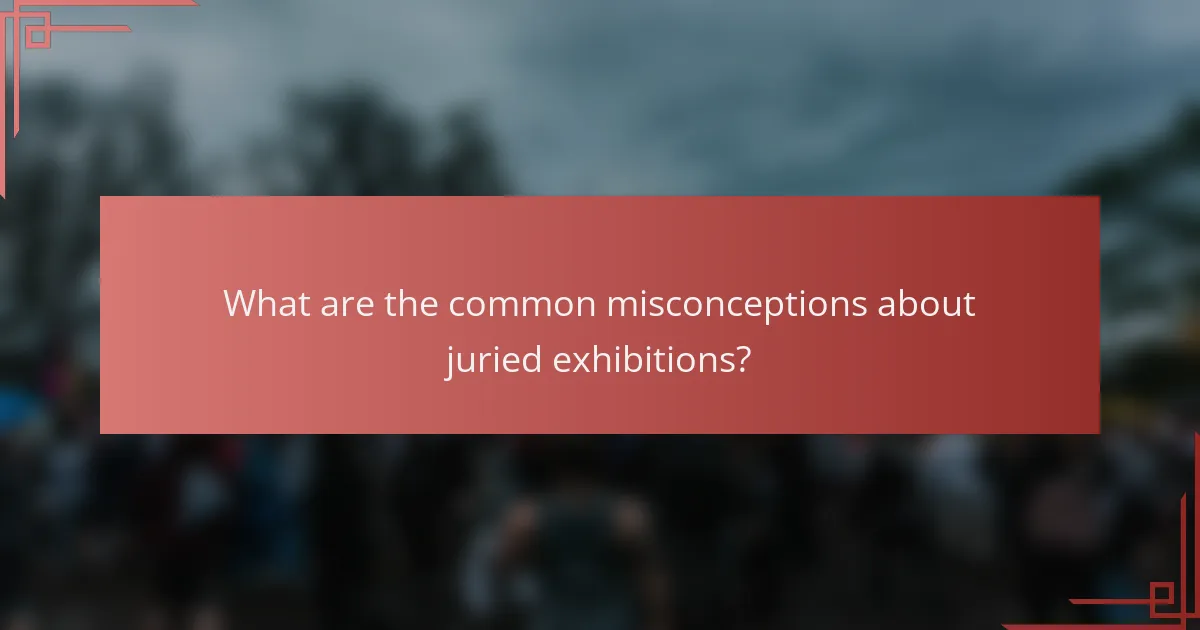
What are the common misconceptions about juried exhibitions?
Many people mistakenly believe that juried exhibitions are elitist or only for established artists. In reality, these exhibitions aim to provide a fair evaluation process that can benefit both emerging and seasoned artists by showcasing their work to a broader audience.
Juried exhibitions are only for professional artists
A common misconception is that only professional artists can participate in juried exhibitions. In fact, many juried shows welcome submissions from artists at all levels, including students and hobbyists. This inclusivity allows for a diverse range of artistic expressions and perspectives.
Emerging artists can gain valuable exposure and experience by participating in juried exhibitions. They often receive constructive feedback from judges, which can help them improve their craft and build their portfolios.
All juried exhibitions are highly competitive
While many juried exhibitions can be competitive, the level of competition varies widely depending on the exhibition’s scope and the number of submissions. Some local or community-based shows may have a more relaxed selection process, allowing more artists to showcase their work.
Artists should research the specific exhibition’s history and acceptance rates to gauge the competitiveness. Understanding the context can help artists make informed decisions about where to submit their work.
Winning a juried exhibition guarantees future success
Winning a juried exhibition can provide recognition and opportunities, but it does not guarantee long-term success in an artist’s career. Many factors contribute to an artist’s trajectory, including networking, marketing, and continued skill development.
Artists should view juried exhibitions as one of many avenues for growth rather than a definitive measure of their potential. Building a robust portfolio and engaging with the art community can lead to more sustainable success over time.
